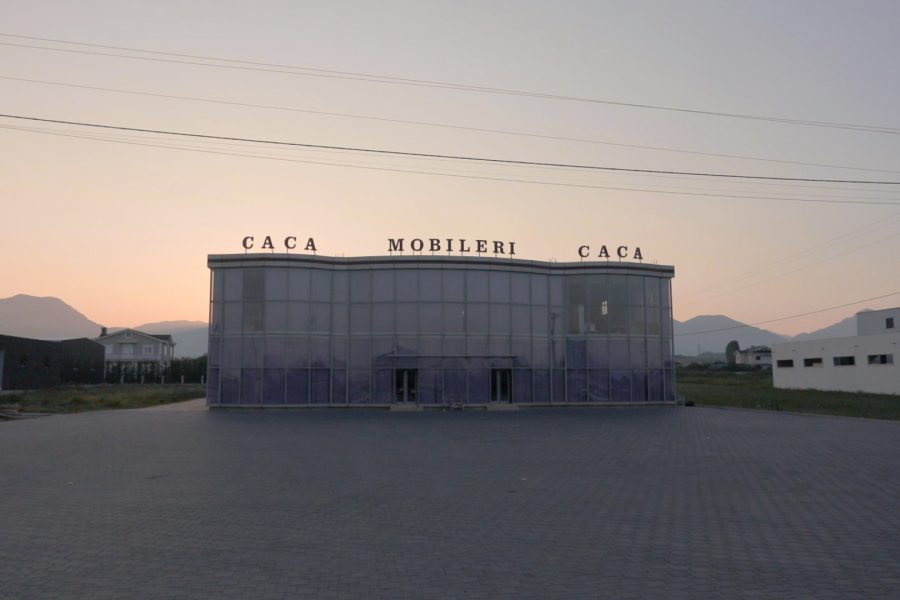Why Kamza
2021
2-channel video project, 9.25 min & 11.04 min
The work of Alban Muja explores different perspectives on geopolitical areas and attributive structures that define national supra-identities which may not seem obvious. Muja’s latest video work continues to question structures that constitute the public while hinting at different political and social patterns based on arbitrary aesthetic moments. How can visible aspects point to a hidden background? How can different social and political meanings appear on the surface of traditional and conservative societies, which generate only a limited range of identities? Similar to some of his previous works, the present works seem to be a metaphor through which the artist wants to draw attention to the dangers of the ideological mechanisms in which we find ourselves as individuals or as a society. This is laid bare by Muja through creating a tension between cultural production and emergent mechanisms of social ideology, its myths, and their relationship. The work Why Kamza refers to The Municipality of Kamza in Albania which was established in the early 1990s, being built illegally and without a plan, just like many businesses that were opened in this area, near the capital, Tirana. Kamza arose after the fall of the dictatorship in Albania, where migration within the Albanian state increased greatly and many families moved from more remote settlements, mainly from the north, to seek a better life near the capital. But as the migration from rural areas to Tirana and its suburbs increased, this also affected the development of these particular areas which became more and more self-sufficient and started to work as sort of D.I.Y areas that were also developed through the businesses people living there had chosen. What stands out in Kamza more than anything else are the ‘Kamza’s furniture shops, which in fact do not even belong to Kamza, as they are located outside the administrative borders of this municipality, although they are known as such. The businesses in which the citizens of this area have focused, often with finances coming from the diaspora, were furniture makers or furniture sellers which were set up one after the other. Consequently to that, almost every business in the vicinity of Kamza is a furniture shop or a furniture workshop. Why Kamza, the latest video work of Alban Muja, is in the first place a visual essay about this very particular place, while in the same breath, it can be seen as a very poetic and “endless” homage to the people of Kamza. Hence, as with many of Muja’s works, this video installation also functions as a critical, ironic, or simply mirroring response to semantic inflation in Albanian’s booming, advertising-saturated economy. With its real but fraying connections to the society in transition, Why Kamaza portraits its ever-changing, unremarkable countenance as something that constitutes a particular locality. Muja’s portrayal and critical understanding could very much relate to the ideas of the eponymous Edward Ruscha’s photo book Every Building on the Sunset Strip (1966), in which he photographed four kilometers of the Sunset Strip in Los Angeles and directly tackled the pervasive clichés that rise between American economy and its culture. It needs to be stressed that Muja uses a similar formal approach in structuring the visual narrative, while its conceptual grounding is very precisely defined in relation to the identity of Kamza and this makes it very actual, not just in the sense of space but also time. This two-channel video installation uses continuous footage that takes inventory of a quotidian Albanian landscape, documents, and simultaneously recreates the streets of Kamza. The work can be understood as an endless confrontation of the tensions that dominate Kamza’s everyday life, tensions and conflicts that stretch between the surface dominated by the advertisements of furniture shops, and the bitterness hidden in the place itself. If at the mythological level, an ideological symbol becomes a method of concealing true character in order to be presented as the truth, then Muja’s portrait of Kamza seeks to dig out these hidden symbols of their attributes and place them in their respective socio-political context and history. This is perhaps the most distinctive mechanism of Alban Muja’s work, which uses ‘visual riddles’ to directly challenge the viewer, while subtly revealing the backgrounds and their hidden stories that make up our lives.
By Tevz Logar

